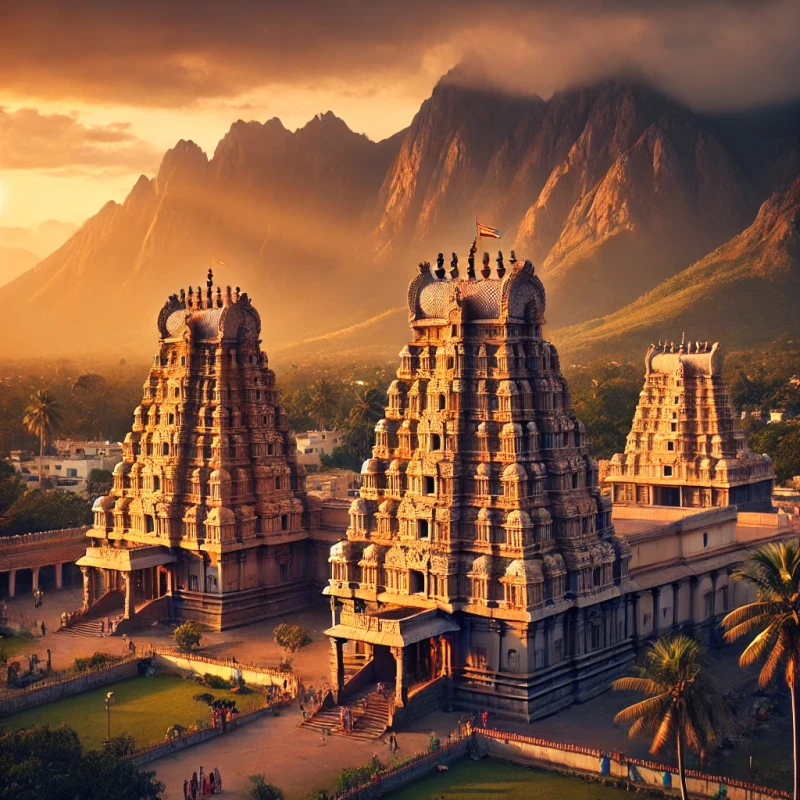- Aug 24, 2024
-
Introduction
Nestled in the serene town of Tiruvannamalai, Tamil Nadu, Arunachalam Temple, also known as Annamalaiyar Temple, is one of India’s most sacred sites dedicated to Lord Shiva. It’s not just a place of worship; it’s a spiritual haven that draws people from all walks of life. Whether you’re a devotee, a history enthusiast, or someone looking to connect with something greater than yourself, this temple offers an experience that lingers long after you’ve left.
The Rich History Behind Arunachalam Temple
The history of Arunachalam Temple is as old as time itself, or at least it feels that way when you step through its ancient gates. Built during the Chola dynasty, this temple has seen countless generations pass through its corridors. It’s mentioned in sacred texts and is one of the oldest temples in South India, which adds to its mystical allure. The towering gopurams (gateway towers) and intricate stone carvings aren’t just architectural feats—they’re stories etched in stone, waiting to be discovered.
Why Arunachalam Temple is So Special
Arunachalam Temple is much more than a physical structure; it’s a symbol of divine energy. The temple is one of the Pancha Bhoota Sthalams, representing the fire element, which is central to Lord Shiva’s mythology. According to legend, this is the spot where Lord Shiva appeared as a column of fire, challenging Lord Vishnu and Lord Brahma to find its beginning and end. The temple’s spiritual significance draws millions of visitors each year, seeking the peace and enlightenment Lord Shiva offers.
Festivals and Rituals: The Temple in Full Bloom
Visiting Arunachalam Temple during a festival is an experience like no other. Karthigai Deepam is the biggest celebration here, where a giant flame is lit atop Arunachala Hill, symbolizing Shiva’s eternal light. The atmosphere is electric, with thousands of devotees gathered to witness this miraculous event. But even if you visit during a quiet time, the daily rituals—poojas, abhishekam, and serene chants—create an ambiance that touches the soul.
How to Get There
Getting to Arunachalam Temple is relatively straightforward. Tiruvannamalai is well-connected by road and rail, and the nearest airport is in Chennai, about 180 kilometres away. You can take a train, bus, or taxi from there to the temple. Once you’re in Tiruvannamalai, the temple is centrally located, making it easy to visit.
When to Visit
Timing your visit can make all the difference. The best time to explore Arunachalam Temple is during the cooler months, from November to February. This is also when the famous Karthigai Deepam festival takes place, making it an ideal time to experience the temple in all its glory. If you prefer a quieter visit, the off-season months will allow you to soak in the temple’s peaceful atmosphere without the crowds.
Tips for a Memorable Visit
- Dress Appropriately: As with most temples in India, modest attire is expected. Men may need to remove their shirts before entering the sanctum sanctorum.
- Walk the Path of Devotion: Consider participating in the Girivalam, a 14-kilometer walk around Arunachala Hill, often done barefoot. It’s a physically and spiritually rewarding experience.
- Beat the Crowds: To avoid long lines, try visiting early in the morning or late in the evening.
- Explore More: Don’t just stop at the temple—take time to explore Arunachala Hill and nearby ashrams for a more rounded spiritual experience.
Architecture that Speaks to the Soul
The architecture of Arunachalam Temple is a blend of devotion and craftsmanship. The massive gopurams, symmetrical layouts, and intricate sculptures all follow Vastu principles, designed to enhance the spiritual energy of the space. The temple is built to align with the cosmos, with the sanctum sanctorum positioned to catch the first rays of the sun. Every stone and every pillar has a story, and wandering through the temple feels like stepping into a sacred timeline.
Connecting Online: Tips for the Modern Devotee
In today’s digital age, it’s easier than ever to plan your visit. Check out the temple’s Google My Business profile, read reviews, and join online forums to gather tips from fellow travelers. These resources can provide up-to-date information on temple timings, special events, and even where to stay nearby. Whether you’re a seasoned pilgrim or a first-time visitor, a little online research can enhance your experience.
A Spiritual Journey Like No Other
Arunachalam Temple is more than just a destination; it’s a journey—both physical and spiritual. As you walk through its ancient corridors, participate in age-old rituals, and feel the energy of the sacred Arunachala Hill, you’ll find that this is a place where time slows down, and the divine feels just a little bit closer.
Whether you’re seeking spiritual enlightenment, historical insights, or simply a peaceful escape, Arunachalam Temple offers all that and more. It’s a place where legends come to life, and every corner has a story to tell. So when you plan your visit, come with an open heart and leave with a soul enriched by the blessings of Lord Shiva.
Conclusion
Arunachalam Temple isn’t just a site on the map; it’s a living, breathing entity that has touched countless lives over the centuries. Whether you’re drawn by its rich history, its spiritual significance, or its architectural beauty, this temple offers an experience that’s both grounding and elevating.
As you prepare for your visit, remember that the journey is as important as the destination. Embrace the rituals, immerse yourself in the temple’s energy, and allow the divine presence of Lord Shiva to guide you on your path.
May your visit to Arunachalam Temple be filled with peace, insight, and the eternal light of Shiva.



Comments :
Currently, there are no comments in this post. Be the first person to comment on this post.